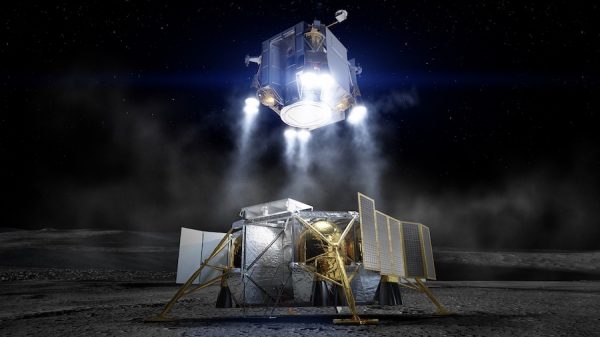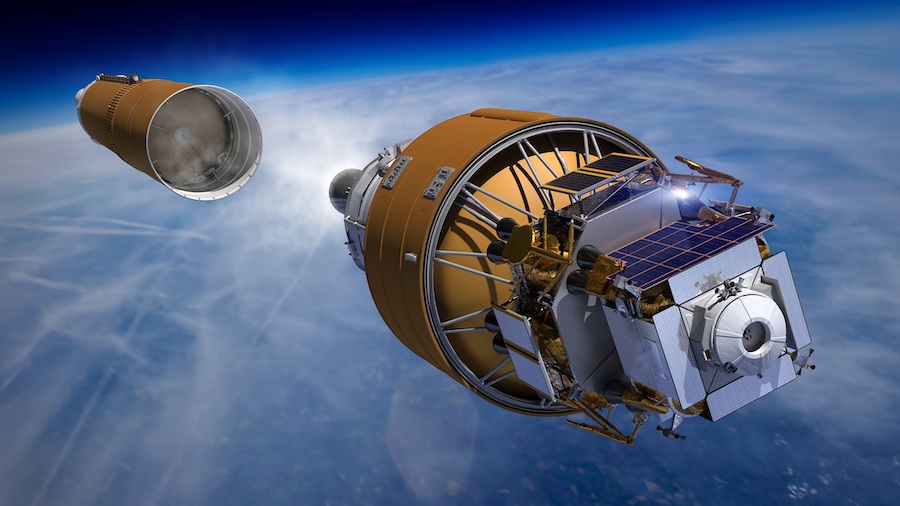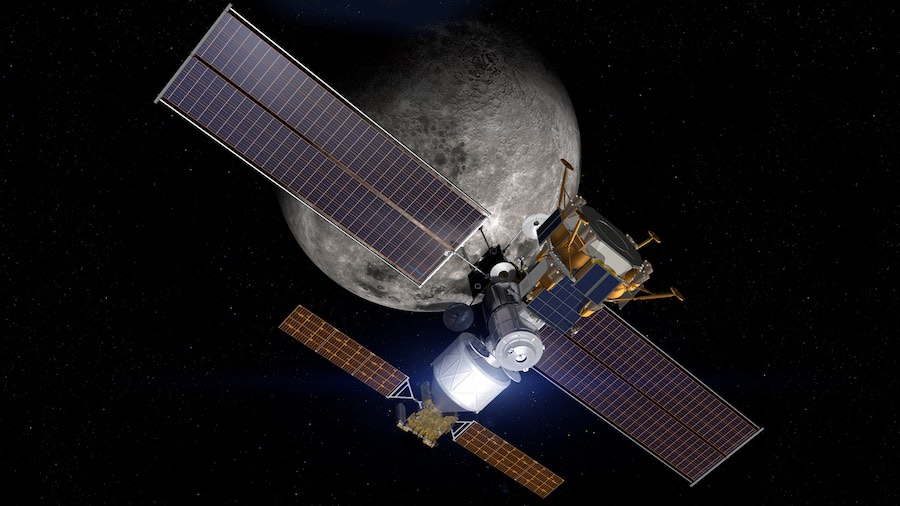Boeing proposes SLS-launched lunar lander – Spaceflight Now
EDITOR’S NOTE: Updated Nov. 10 to correct references to ascent and descent stage functions.

Boeing is touting a lunar lander concept that the company claims could launch in one piece on an upgraded version of NASA’s Space Launch System heavy-lift rocket — which Boeing largely builds — and deliver astronauts to the moon’s surface in 2024 without going through NASA’s planned Gateway mini-space station.
The lunar lander proposal submitted by Boeing to NASA is one of multiple concepts proposed by U.S. industry. Companies had to send in their lunar lander proposals to NASA by Tuesday, Nov. 5, on an accelerated timetable to meet the Trump administration’s goal of landing astronauts on the moon’s south pole by the end of 2024.
Details of two of the lunar lander proposals have been revealed.
Blue Origin, the company established billionaire Jeff Bezos, is partnering with Lockheed Martin, Northrop Grumman and Draper to develop a three-component lunar lander that could launch on commercial rockets, such as Blue Origin’s own New Glenn booster. Boeing is taking a different approach, proposing to launch a lunar lander on a single flight of the Space Launch System.
“When you try to carve that (lander) up into smaller pieces, some of the smaller pieces don’t work on some of the existing commercial launchers, so we ended up backing into an architecture that really works best using the largest rocket possible,” said Peter McGrath, director of global sales and marketing for Boeing’s space exploration division.
Boeing builds the SLS core stage, and NASA has charged Boeing with developing an upgraded Exploration Upper Stage to upgrade the SLS’s lift capability. The uprated SLS, known as the Block 1B configuration, could launch Boeing’s lander on a single flight, according to McGrath.
Boeing argues that using the SLS Block 1B to launch the lunar lander on a single launch “reduces the complexity and risk of sending multiple segments to orbit on multiple launches.” The company said its proposal enables a crewed landing on the moon requiring only five “mission critical events instead of the 11 or more required by alternate strategies,” where individual lander elements would rendezvous together near the moon and be assembled robotically.
In its solicitation for Human Landing System proposals, NASA requested companies propose commercially-developed vehicles, in which the contractors would be responsible for designing, building and launching the landers. Commercial operators would then fly the landers to an orbit near the moon for the rendezvous of an Orion crew capsule carrying NASA astronauts, who would board the landers for descent to the lunar surface.
In parallel with work on the human-rated landers, the SLS and Orion crew capsule, NASA is moving forward with plans to build a mini-space station near the moon. The combined lunar exploration initiative is named Artemis, after the twin sister of Apollo in Greek mythology.
The first piece of the Gateway station, known as the Power and Propulsion Element, is being built by Maxar for launch by the end of 2022. A Northrop Grumman-built mini-habitation module would join the Gateway after a launch in late 2023, setting the stage for the arrival of a landing craft in 2024, followed by the docking of an Orion crew capsule on the Artemis 3 mission with the lunar landing crew.
The Gateway is slated to fly in an elliptical near rectilinear halo orbit, taking the complex as close as 1,000 miles (1,500 kilometers) and as far as 43,500 miles (70,000 kilometers) from the moon. NASA selected the orbit because it allows a continuous communications link with Earth, and landers departing from the Gateway can reach any place on the lunar surface with only modest propellant usage.
McGrath said Boeing determined the most effective way to land astronauts on the moon in 2024 is to develop a lander with just two elements — without a orbit transfer module — that could achieve its mission with or without NASA’s planned Gateway station in lunar orbit.
“It’s an ascent element and a descent element, where the descent element actually performs the function of all the transfer to get you from the halo orbit that Gateway or Orion are in, all the way to the surface of the moon,” McGrath said in an interview with Spaceflight Now. “Then the ascent element is capable from taking you from the south pole all the way back to rendezvous with the Gateway or Orion.”

“The way we’ve sized it, you avoid needing a third element, which really simplifies the architecture because you really have one rendezvous in space instead of a ballet of rendezvous (operations) in space,” McGrath said. “With the ascent (and) descent elements flying integrated on one launch, our architecture also offers a lot of flexibility in the sense that we can either dock directly with Orion or we can dock with the Gateway, whichever NASA prefers.
“And in the case the Gateway is delayed, it doesn’t delay your (Artemis 3) launch in ’24,” McGrath said. “So it really allows you to do the minimal number of maneuvers and dockings to actually get to the surface of the moon.
“Our architecture still assumes that we’re all arriving in the near rectilinear halo orbit, so we’re all going to that same orbit and doing all the maneuvers off that orbit to the surface,” McGrath said.
McGrath said NASA will eventually need the Gateway to enable a more “extensible architecture” for exploration of the lunar surface.
Boeing’s proposal makes an assumption about the readiness of the Exploration Upper Stage that, so far, NASA has not been comfortable making in its Artemis mission planning.
The first three Artemis flights are planned to use a base configuration of the Space Launch System known as the Block 1. The SLS Block 1 rocket will fly with Interim Cryogenic Propulsion Stages, each utilizing a single RL10 engine. The EUS will be powered by four RL10 engines, giving the SLS Block 1B the capability to deliver more than 81,000 pounds, or about 37 metric tons, on a direct trajectory toward the moon.
The lunar lift capabilities of other commercial launchers NASA expects to be available in 2024 — such as SpaceX’s Falcon Heavy, Blue Origin’s New Glenn, and United Launch Alliance’s Vulcan Centaur — do not match that of the SLS. But the exact lift capabilities to the moon for those rockets have not been publicly disclosed.
NASA still plans to introduce the Exploration Upper Stage for the SLS in the mid-2020s, but agency officials say using commercial rockets for the Gateway and lunar lander elements will be less expensive than upgrading the SLS and increasing the SLS launch rate.
In a September congressional hearing, Ken Bowersox, then the acting head of NASA’s human spaceflight division, said the space agency considers upgrading the SLS to the Block 1B configuration with the EUS as “an important future capability.” He added that “recent performance issues and delays” in Boeing’s manufacture of the first SLS core stage forced NASA to prioritize the completion of future SLS core stages to establish an annual SLS/Orion launch cadence leading up to the Artemis 3 lunar landing mission.

Cost is also among NASA’s concerns with launching Gateway or lunar lander elements on the Space Launch System. One cost estimate, included in a letter recently sent by the White House to the Senate Appropriations Committee, puts the cost of a single SLS launch at more than $2 billion, according to Ars Technica.
The launch prices of commercial rockets like the Falcon Heavy, New Glenn and Vulcan Centaur are a fraction of that of the Space Launch System.
In the same letter, the White House said that NASA’s lunar exploration program — as currently envisioned — “requires every SLS rocket available.”
“Industry has looked at this, and we believe there’s not an issue with actually having a Block 1B available in 2024,” McGrath said. “It’s really just about prioritization to get it there. It’s definitely not a development timeline constraint. We felt we could get one as early as July of ’24, which is kind of what we’re targeting as a launch date.”
Boeing would have to pay for the cost of the SLS launch of its lunar lander, money that would be built in to the company’s lunar lander contract with NASA, assuming Boeing is a winner in the HLS competition.
McGrath said Boeing could assess other commercial launch alternatives for the lander if the SLS Block 1B is not available in 2024. For example, the Boeing lander’s descent element could theoretically launch on an SLS Block 1 rocket — with the single-engine upper stage — and the lander’s ascent module could launch separately on a commercial rocket, he said.
“Getting a descent element of any size on a commercial launcher becomes a constraint, which is what drove us toward SLS,” McGrath said. “Depending on what the actual (commercial) launch performance numbers are, which are not known right now, we could look at that, but the baseline right now is SLS, and that’s where the right performance needs to be.”
McGrath said Boeing is considering at least two potential subcontractors to provide propulsion systems for the company’s lunar lander.
“Our typical propulsion partner tends to be Aerojet Rocketdyne,” he said. “We are looking at alternate sources, too, depending on their maturity, but there are some off-the shelf engines that we’re looking at from Aerojet Rocketdyne, that are flying on commercial crew, so existing engines.”
Boeing is looking at storable hypergolic propellant systems for the engines on the 2024 lunar landing mission, McGrath said. Blue Origin’s lunar lander concept would be fueled by cryogenic methane, a higher-performing fuel than the hydrazine used in hypergolic systems.
McGrath said Boeing is currently planning to cluster multiple orbital maneuvering and attitude control engines on the ascent and descent elements of the lunar lander. The engines come from the company’s Starliner commercial crew capsule program.
But that could change. McGrath stressed Boeing is still finalizing the lander design.
Boeing’s lander would be capable of carrying a two-person crew to the lunar surface in 2024, meeting the requirements set in NASA’s solicitation for a Human Landing System. Future landers could include reusable ascent modules and cryogenic engines, McGrath said.
Boeing is partnering with Intuitive Machines, a Houston-based startup, on cryogenic propulsion and flight software for lunar landing applications. Intuitive Machines is one of two companies under contract to NASA to fly robotic landers to the moon in 2021.
Besides the possible application of Starliner engines, the Boeing lunar lander will utilize technology from the Boeing 702 spacecraft bus, which is used as a platform for commercial and military communications satellites, and will use flight computers from the Space Launch System.
“So it’s going to have a lot of flight heritage behind it, which gives us high confidence of being able to do this in a compressed schedule,” McGrath said.
NASA is waiting on a final fiscal year 2020 budget appropriation from Congress before deciding how ambitiously the agency can proceed with the lunar lander procurement.
The White House in May requested a $1.6 billion budget augmentation as a “down payment” for the accelerated Artemis lunar landing program, which aims to move up NASA’s schedule for a crewed moon landing from 2028 to 2024. About $1 billion of that budget is dedicated to kick-starting development of human-rated lunar landing craft.
NASA would require additional funding for lunar landers in subsequent years.
NASA officials hope to select at least three commercial lunar lander concepts for 10-month study contracts, then down-select to two providers to develop landing spacecraft for missions in 2024 and 2025.
NASA Administrator Jim Bridenstine said last month that an appropriation from Congress of less than $1 billion for lunar landers in 2020 would reduce the chance of achieving a crewed return to the moon’s surface within five years.
“We might not be able to have multiple companies competing at the same time for that Human Landing System,” Bridenstine said, referring to the consequence of a Senate funding bill that would provide NASA with $744 million of the requested $1 billion for Human Landing Systems in 2020.
“And what we find historically is that when we don’t have multiple companies competing, we end up with cost overruns, schedule delays,” Bridenstine said in an interview with Spaceflight Now. “And in many cases, it costs more money, not less money. Of course, we also miss out on the dissimilar redundancy, which is good. If there is a setback, we can keep moving forward with a different partner. So all of these things reduce the probability of success, but I’m not saying that we can’t be successful.”
Email the author.
Follow Stephen Clark on Twitter: @StephenClark1.






